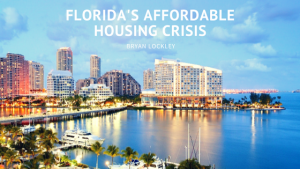Take a drive through Miami Beach along the waterfront where behemoth mcmansions tower over the ocean, and then take a drive through downtown where homeless people live on the streets, and it’s not hard to see the discrepancy in affordable housing options. Florida is home to the third highest number of people (33,599) living in shelters or on the street, yet it is also the playing field of the mega rich, with Miami’s most expensive home on the market listed for $65 million.
Florida’s accessibility to affordable housing has reached the crisis level, particularly in South Florida, as evidenced by a dramatic shift in population. Whereas several years ago, more people were moving to South Florida from other parts of America than moving out, now far more are leaving the area than moving in. The region has seen a total reversal in domestic migration since 2013, with net domestic migration dropping 2,670% since 2010. Net international migration has increased by 397 percent in that same time period, however, more than offsetting the loss of domestic residents. The Miami metropolitan area actually saw an 8.6% population increase between 2010 and 2016, but the majority of this growth comes from increased international immigration. The region’s demographic has seen dramatic change, which is concerning for current middle-class residents or middle-income retirees looking to move to the area.
Florida construction is booming, but it’s not affordable or low-income housing that developers are profiting from, but luxury condominiums and mansions. According to the executive vice president of the Florida Chamber Foundation, Tony Carvajal, “Young people making $30,000 to $60,000 can’t afford to live where they work.”
The statistics for housing in this area attest to Carvajal’s statement. In 2013, 715,000 Floridian households spent more than 40 percent of their income on housing, and in 2016, that number increased to 911,000 households spending more than half their income on housing. The median price of a single-family home in Miami-Dade is $321,000. According to a 2016 Demographia International Housing Survey, South Florida has the third highest gap between home prices and wages, behind only Honolulu and California.
Conversely, as expensive properties continue to rise, the pool of affordably priced homes on the market is shrinking and becoming increasingly more competitive. Keyes Company, a local real estate brokerage company, cites that the number of homes valued between $250,000 and $600,000 has dropped 18 percent over the last two years.
It will take a concerted effort from Florida’s government to resolve the housing crisis and make homeownership affordable for middle and lower-class residents once more.

